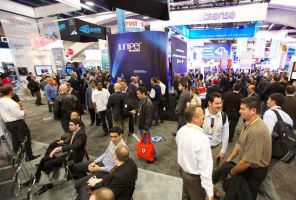RSA Conference Day 2 - Wednesday
We are at RSA Conference in San Francisco this week, keeping current with the latest developments in the information security industry. With 40,000 attendees, this is one of the biggest annual events focused on security. We'll be summarizing the developments here in daily blogs, as well as live-tweeting the high points at our Twitter account @Path2Protection
Today was breakout/track sessions in the morning, with some keynotes in the afternoon. We also hit the expo floor hard today, but will cover that in a separate post.
"Giving the Bubble Boy an Immune System so He Can Play Outside" - Kevin Mahaffey
Kevin Mahaffey (@dropalltables) is the founder and CTO of Lookout, one of the first mobile-centric security/anti-malware companies.
This talk is intended to explore how many large and forward-thinking companies are removing many traditional elements of security architecture (e.g., anti-virus, VPNs, firewalls) in favor of a data-driven security model. The talk was given on 02 March 2016 at the RSA Conference in San Francisco.
REACTION:
I am a big fan of the concept of internal resilience and immunity as an approach to security, as opposed to building a bigger, better wall at the perimeter. This is a more and more important approach as mobile devices, BYOD, external cloud service providers, and other trends take hold in organizations. I'm not convinced that the data-driven approach is the road forward, though. Data analytics is a powerful tool, but at some point it becomes an exercise in navel-gazing. If you literally log and watch everything, including the system that is storing and analyzing the logs, the data grows virtually without limit. Big data technologies are making this more practical, but detection and remediation still lag. The ideas Kevin is sharing are very interesting, but these methods still seem like an enhancement to me, rather than a replacement for traditional security devices/software.
The best resource mentioned was the Google "Beyond Corp" paper.
"Proactive Measures to Mitigate Insider Threat" - Andrew Case
Andrew Case (@attrc), Director of Research at Volexity, an infosec advisory firm headquartered in Washington, DC. This talk was surprisingly well-attended; the most packed session I’ve been to. I guess insider threat is weighing heavy on people's minds these days?
REACTION:
Andrew's case examples were very interesting, and the strategies he gives are sensible, if not revolutionary. Limiting and monitoring the use of removable media and of cloud file sync/storage services is a strong recommendation which I make to many of my clients. Identifying where your key intellectual property is located and concentrating monitoring on those locations is another excellent recommendation. Separation of duties is a common requirement, but a difficult one for many organizations to implement. Tighter controls on users at termination and inventory of issued equipment down to the level of noting serial numbers of hard drives and other components of laptops is also a stretch for most organizations.
Keynotes:
I actually hit the vendor expo during the keynotes this afternoon, so I missed a lot of the keynotes. There were only two I found particularly interesting, and I took in enough of those to give some notes.
"Ascending the Path to Better Security" - Marty Roesch - VP & Chief Architect, Cisco Security Group
Marty addressed the issue of increasing complexity and diversity of security tools and technologies. He said that it's not necessarily true that "complexity is the enemy of security" as long as the complexity actually delivers increased performance, detection, prevention, and/or response. However, Marty argued that we are reaching a point of diminishing returns as we increase the complexity and sophistication of our security tools. The complexity curve continues to get steeper, but the gains in actual outcomes are diminishing at the same time. Marty said we need to do three things:
"Turning the Tables: Radical New Approaches to Security Analytics" - Martin Fink - EVP, CTO, HP Enterprise
Big data analytics has truly revolutionized what we can do with the data available in cyber security. We used to look at all the log data and packet data and think, "It would be great to store and search through all this, but it's just too much data to be feasible." That's no longer true. The "big data" revolution and the continuing advances in storage technology have changed the landscape. It is now feasible to capture, store, aggregate, and analyze the logs from every device in your network, or the contents of every packet that crosses your network.
Martin Fink started by talking about the need to build security into every part of the system, rather than just the perimeter. Starting from the silicon and the firmware, the state of the system should be checked for integrity and should have a built-in recovery capability to a known good state. The operating system, as well, should be checked for integrity and have a capability to restore itself to a known good state.
"Analytics-Driven Intelligent SOC"
Today was breakout/track sessions in the morning, with some keynotes in the afternoon. We also hit the expo floor hard today, but will cover that in a separate post.
"Giving the Bubble Boy an Immune System so He Can Play Outside" - Kevin Mahaffey
Kevin Mahaffey (@dropalltables) is the founder and CTO of Lookout, one of the first mobile-centric security/anti-malware companies.
This talk is intended to explore how many large and forward-thinking companies are removing many traditional elements of security architecture (e.g., anti-virus, VPNs, firewalls) in favor of a data-driven security model. The talk was given on 02 March 2016 at the RSA Conference in San Francisco.
REACTION:
I am a big fan of the concept of internal resilience and immunity as an approach to security, as opposed to building a bigger, better wall at the perimeter. This is a more and more important approach as mobile devices, BYOD, external cloud service providers, and other trends take hold in organizations. I'm not convinced that the data-driven approach is the road forward, though. Data analytics is a powerful tool, but at some point it becomes an exercise in navel-gazing. If you literally log and watch everything, including the system that is storing and analyzing the logs, the data grows virtually without limit. Big data technologies are making this more practical, but detection and remediation still lag. The ideas Kevin is sharing are very interesting, but these methods still seem like an enhancement to me, rather than a replacement for traditional security devices/software.
The best resource mentioned was the Google "Beyond Corp" paper.
"Proactive Measures to Mitigate Insider Threat" - Andrew Case
Andrew Case (@attrc), Director of Research at Volexity, an infosec advisory firm headquartered in Washington, DC. This talk was surprisingly well-attended; the most packed session I’ve been to. I guess insider threat is weighing heavy on people's minds these days?
REACTION:
Andrew's case examples were very interesting, and the strategies he gives are sensible, if not revolutionary. Limiting and monitoring the use of removable media and of cloud file sync/storage services is a strong recommendation which I make to many of my clients. Identifying where your key intellectual property is located and concentrating monitoring on those locations is another excellent recommendation. Separation of duties is a common requirement, but a difficult one for many organizations to implement. Tighter controls on users at termination and inventory of issued equipment down to the level of noting serial numbers of hard drives and other components of laptops is also a stretch for most organizations.
Keynotes:
I actually hit the vendor expo during the keynotes this afternoon, so I missed a lot of the keynotes. There were only two I found particularly interesting, and I took in enough of those to give some notes.
"Ascending the Path to Better Security" - Marty Roesch - VP & Chief Architect, Cisco Security Group
Marty addressed the issue of increasing complexity and diversity of security tools and technologies. He said that it's not necessarily true that "complexity is the enemy of security" as long as the complexity actually delivers increased performance, detection, prevention, and/or response. However, Marty argued that we are reaching a point of diminishing returns as we increase the complexity and sophistication of our security tools. The complexity curve continues to get steeper, but the gains in actual outcomes are diminishing at the same time. Marty said we need to do three things:
- Integration - Interoperable security technologies that talk to each other to make them smarter.
- Consolidation - Fewer "things" with more capabilities. To achieve this, we need true security "platforms" that are extensible with open programming interfaces so that others can build on them.
- Automation - automate analytics by programmatically contextualizing events.
Big data analytics has truly revolutionized what we can do with the data available in cyber security. We used to look at all the log data and packet data and think, "It would be great to store and search through all this, but it's just too much data to be feasible." That's no longer true. The "big data" revolution and the continuing advances in storage technology have changed the landscape. It is now feasible to capture, store, aggregate, and analyze the logs from every device in your network, or the contents of every packet that crosses your network.
Martin Fink started by talking about the need to build security into every part of the system, rather than just the perimeter. Starting from the silicon and the firmware, the state of the system should be checked for integrity and should have a built-in recovery capability to a known good state. The operating system, as well, should be checked for integrity and have a capability to restore itself to a known good state.
"Analytics-Driven Intelligent SOC"
- Real-Time Monitoring: the foundation of any security operation
- Deep Analytics: investigation & hunting augmented by machine learning; enables detection of unknown threats through behavioral analysis
- Deception Grid: redirect attacks to a test network/host for study/analysis
The False Positive Problem:
-- The Base Rate Fallacy: when looking for rare events, even a low rate of failure in proper identification leads to a large number of failures
-- The solution is more advanced analytics that correlate many events over time; false positives will usually be discarded because one event may be mistaken for an attack indicator, but that event will almost always fail to be accompanied by the other expected events associated with that attack.
HP is working on research to build "The Machine" -- a memory-driven machine where memory precedes processing in order to overcome processor limitations on the quantity of data that can be processed and the speed with which it can be processed. This machine, with 640TB of main system memory, could process 10 million events/second and analyze up to 14 days worth of events.
-- The Base Rate Fallacy: when looking for rare events, even a low rate of failure in proper identification leads to a large number of failures
-- The solution is more advanced analytics that correlate many events over time; false positives will usually be discarded because one event may be mistaken for an attack indicator, but that event will almost always fail to be accompanied by the other expected events associated with that attack.
HP is working on research to build "The Machine" -- a memory-driven machine where memory precedes processing in order to overcome processor limitations on the quantity of data that can be processed and the speed with which it can be processed. This machine, with 640TB of main system memory, could process 10 million events/second and analyze up to 14 days worth of events.




Comments
Post a Comment